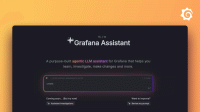This is documentation for the next version of Grafana Alloy Documentation. For the latest stable release, go to the latest version.
loki.write
loki.write receives log entries from other loki components and sends them over the network using the Loki logproto format.
You can specify multiple loki.write components by giving them different labels.
Usage
loki.write "<LABEL>" {
endpoint {
url = "<REMOTE_WRITE_URL>"
}
}Arguments
You can use the following arguments with loki.write:
Blocks
You can use the following blocks with loki.write:
The > symbol indicates deeper levels of nesting.
For example, endpoint > basic_auth refers to a basic_auth block defined inside an endpoint block.
endpoint
The endpoint block describes a single location to send logs to.
You can use multiple endpoint blocks to send logs to multiple locations.
The following arguments are supported:
At most, one of the following can be provided:
authorizationblockbasic_authblockbearer_token_fileargumentbearer_tokenargumentoauth2block
no_proxy can contain IPs, CIDR notations, and domain names. IP and domain names can contain port numbers.
proxy_url must be configured if no_proxy is configured.
proxy_from_environment uses the environment variables HTTP_PROXY, HTTPS_PROXY, and NO_PROXY (or the lowercase versions thereof).
Requests use the proxy from the environment variable matching their scheme, unless excluded by NO_PROXY.
proxy_url and no_proxy must not be configured if proxy_from_environment is configured.
proxy_connect_header should only be configured if proxy_url or proxy_from_environment are configured.
If no tenant_id is provided, the component assumes that the Loki instance at endpoint is running in single-tenant mode and no X-Scope-OrgID header is sent.
When multiple endpoint blocks are provided, the loki.write component creates a client for each.
Received log entries are fanned-out to these clients in succession.
That means that if one client is bottlenecked, it may impact the rest.
Endpoints can be named for easier identification in debug metrics by using the name argument. If the name argument isn’t provided, a name is generated based on a hash of the endpoint settings.
The retry_on_http_429 argument specifies whether HTTP 429 status code responses should be treated as recoverable errors.
Other HTTP 4xx status code responses are never considered recoverable errors.
When retry_on_http_429 is enabled, the retry mechanism is governed by the backoff configuration specified through min_backoff_period, max_backoff_period and max_backoff_retries attributes.
authorization
credential and credentials_file are mutually exclusive, and only one can be provided inside an authorization block.
Warning
Using
credentials_filecauses the file to be read on every outgoing request. Use thelocal.filecomponent with thecredentialsattribute instead to avoid unnecessary reads.
basic_auth
password and password_file are mutually exclusive, and only one can be provided inside a basic_auth block.
Warning
Using
password_filecauses the file to be read on every outgoing request. Use thelocal.filecomponent with thepasswordattribute instead to avoid unnecessary reads.
oauth2
client_secret and client_secret_file are mutually exclusive, and only one can be provided inside an oauth2 block.
Warning
Using
client_secret_filecauses the file to be read on every outgoing request. Use thelocal.filecomponent with theclient_secretattribute instead to avoid unnecessary reads.
The oauth2 block may also contain a separate tls_config sub-block.
no_proxy can contain IPs, CIDR notations, and domain names. IP and domain names can contain port numbers.
proxy_url must be configured if no_proxy is configured.
proxy_from_environment uses the environment variables HTTP_PROXY, HTTPS_PROXY, and NO_PROXY (or the lowercase versions thereof).
Requests use the proxy from the environment variable matching their scheme, unless excluded by NO_PROXY.
proxy_url and no_proxy must not be configured if proxy_from_environment is configured.
proxy_connect_header should only be configured if proxy_url or proxy_from_environment are configured.
queue_config
EXPERIMENTAL: This is an experimental feature. Experimental features are subject to frequent breaking changes, and may be removed with no equivalent replacement. To enable and use an experimental feature, you must set the
stability.levelflag toexperimental.
The optional queue_config block configures, when WAL is enabled, how the underlying client queues batches of logs sent to Loki.
Refer to Write-Ahead block for more information.
The following arguments are supported:
tls_config
The following pairs of arguments are mutually exclusive and can’t both be set simultaneously:
ca_pemandca_filecert_pemandcert_filekey_pemandkey_file
When configuring client authentication, both the client certificate (using cert_pem or cert_file) and the client key (using key_pem or key_file) must be provided.
When min_version isn’t provided, the minimum acceptable TLS version is inherited from Go’s default minimum version, TLS 1.2.
If min_version is provided, it must be set to one of the following strings:
"TLS10"(TLS 1.0)"TLS11"(TLS 1.1)"TLS12"(TLS 1.2)"TLS13"(TLS 1.3)
wal
EXPERIMENTAL: This is an experimental feature. Experimental features are subject to frequent breaking changes, and may be removed with no equivalent replacement. To enable and use an experimental feature, you must set the
stability.levelflag toexperimental.
The optional wal block configures the Write-Ahead Log (WAL) used in the Loki remote-write client.
To enable the WAL, you must include the wal block in your configuration.
When the WAL is enabled, the log entries sent to the loki.write component are first written to a WAL under the dir directory and then read into the remote-write client.
This process provides durability guarantees when an entry reaches this component. The client knows when to read from the WAL using the following two mechanisms:
- The WAL-writer side of the
loki.writecomponent notifies the reader side that new data is available. - The WAL-reader side periodically checks if there is new data, increasing the wait time exponentially between
min_read_frequencyandmax_read_frequency.
The WAL is located inside a component-specific directory relative to the storage path Alloy is configured to use.
Refer to the run documentation for more information about how to change the storage path.
The following arguments are supported:
Exported fields
The following fields are exported and can be referenced by other components:
Component health
loki.write is only reported as unhealthy if given an invalid configuration.
Debug information
loki.write doesn’t expose any component-specific debug information.
Debug metrics
loki_write_batch_retries_total(counter): Number of times batches have had to be retried.loki_write_dropped_bytes_total(counter): Number of bytes dropped because failed to be sent to the ingester after all retries.loki_write_dropped_entries_total(counter): Number of log entries dropped because they failed to be sent to the ingester after all retries.loki_write_encoded_bytes_total(counter): Number of bytes encoded and ready to send.loki_write_request_duration_seconds(histogram): Duration of sent requests.loki_write_sent_bytes_total(counter): Number of bytes sent.loki_write_sent_entries_total(counter): Number of log entries sent to the ingester.loki_write_stream_lag_seconds(gauge): Difference between current time and last batch timestamp for successful sends.
Examples
The following examples show you how to create loki.write components that send log entries to different destinations.
Send log entries to a local Loki instance
You can create a loki.write component that sends your log entries to a local Loki instance:
loki.write "local" {
endpoint {
url = "http://loki:3100/loki/api/v1/push"
}
}Send log entries to a managed service
You can create a loki.write component that sends your log entries to a managed service, for example, Grafana Cloud. The Loki username and Grafana Cloud API Key are injected in this example through environment variables.
loki.write "default" {
endpoint {
url = "https://logs-xxx.grafana.net/loki/api/v1/push"
basic_auth {
username = sys.env("LOKI_USERNAME")
password = sys.env("GRAFANA_CLOUD_API_KEY")
}
}
}Technical details
loki.write uses snappy for compression.
Any labels that start with __ are removed before sending to the endpoint.
Compatible components
loki.write has exports that can be consumed by the following components:
- Components that consume Loki
LogsReceiver
Note
Connecting some components may not be sensible or components may require further configuration to make the connection work correctly. Refer to the linked documentation for more details.



